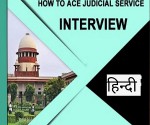HCS JUDICIAL EXAM
1. The Directive Principles of State Policy as embodied in Chapter IV of the Constitution were derived by us from:-
a. The Constitution of Ireland
b. The Constitution of U.S.S.R.
c. The Constitution of Switzerland
d. The Gandhian Constitution for Free India
2. State which of the following statements is correct:
a. Preamble is not part of the Constitution
b. Preamble is part of the Constitution and relates to its basic structure.
c. Preamble is not part of the Constitution but a sort of introduction to the Constitution.
d. Preamble is like a prologue to the Constitution
3. State which of the following statements is correct:-
a. The American doctrine of waiver of fundamental rights is part of the Indian Constitution. .
b. No person can waive his fundamental rights under the Indian Constitution as they are sacrosanct and no individual can tinker with them.
c. A non-citizen can waive his fundamental rights.
d. A citizen can waive his fundamental rights which are for his individual benefit.
4. The right to equality means that no person is above law. To this rule, certain exceptions are recognized. State which of the following come under the exception:
a. President of India
b. Ambassador of USA.
c..Judges of the High Courts.
d. All the above
5. Which one of the following writs can be issued only against the judicial or quasi-judicial authorities?
a. Mandamus
b. Habeas Corpus
c. Certiorari
d. Quo Warranto
6. State which of the following statements is incorrect:
a. A writ can be issued against the High Court.
b. Government of India and State Governments.
c. Any authority under the power and control of the Government of India.
d. Parliament or a State Legislature.
7. The Directive Principles are:-
a. justiciable the same way as the fundamental rights.
b. justiciable though not the same way as the fundamental rights.
c. decorative portions of the Indian Constitution.
d. not justiciable, yet fundamental in the governance of the country
8.Which coin out of the following has been withdrawn by RBI in 2011:
a. 20Paisa
b. 10 paisa
c. 25Paisa
d. 5 paisa
9. The total number of Ministers, including the Prime Minister in the Council of Minister should not exceed:-
a. 20%of the total number of members of Lok Sabha.
b. 15%of the total number of members of Lok Sabha.
c. 20%of the total number of members of Rajya Sabha.
d. 15%of the total number of members of both the Houses.
10. Whohas been conferred with Rajiv Gandhi Khel Ratna Award in the year 2011.
a. Abhinav Bindra
b. Gagan Narang
c. Kapil Dev
d. Sachin Tendulkar
11. Vast powers and functions vested in the Indian President make him:
a. Almosta dictator
b.A benevolent ruler
c. Real head of the Government
d.A nominal Constitution Head
12. Only that person can be appointed a judge of the Supreme Court who is a citizen of Indiaand:
a. judge of the High Court for at least five years.
b. advocate of the Supreme Court for at least 10 years’ standing.
c. judge of the High Court for at least ten years.
d. advocate of the High Court for at least fifteen years.
13. While a proclamation of emergency is in operation the State Government:-
a. Cannot legislate.
b. Can legislate only on subjects in the Concurrent List.
c. Can legislate on the subject in the State List.
d. Is suspended.
14. ‘What cannot be done directly cannot be done indirectly’. This statement epitomises the doctrine of:-
a. Pith and substance.
b. Implied powers.
c. Ancillary powers
d. Colourable legislation.
15. Residuary powers are vested in:
a. executive
b. judiciary
c. parliament
d. state legislatures
16. Who said that the Supreme Court in India has the highest powers which no other court in the world possess?
a. Mahatma Gandhi
b. Jawahar Lal Nehru
c. Sardar Vallabh Bhai Patel
d. Alladi Krishna Swamy Iyyer
17. The Constitution of India is:-
a. Highly federal
c. Neither federal nor unitary
b. Highly unitary
d. Partly federal and partly unitary
18. Who amongst the following is not a ‘public officer’ within the meaning of Section 2 (17) of CPC.
a. a Judge
b. a person in service under the pay of Government
c. sarpanch of a Gram Panchayat
d. all of the above
19. Give response to the statement Equality before law under Article 14 of the Constitution is with reference to
a. laws enacted by legislature
b. orders passed by the executive
c. notifications issued by the Government only
d. laws enacted by legislature, executive order etc.
20. A change of nature of obligation of a contract is known as
a. repudiation
b. rescission
c. alteration
d. none of the above
21.1ndira Swahney V. Union of India is a case popularly known as:
a. Ayodhya judgment
b. Mandai judgment
c. Suicide judgment
d. Election Commission judgment
22.The Advisory opinion tendered by the Supreme Court:
a. is binding on the President
b. is not binding on the President
c. is binding on the President only if it is unanimously made
d. is not made public at all
23.Among the following States, which one sends the highest number of members to Lok Sabha?
a. Andhra Pradesh
b. Bihar
c. Kamataka
d. Madhya Pradesh
24. A contract, which is formed without the free consent of the parties, is
a. void ab initio
b. void
c. illegal
d. void ableat the instance of the party whose consent was not free.
25. Which of the following legal pleas need not be pleaded
a. estoppel
b. limitation
c. res-judicata
d. none of the above51. Under Order VI, Rule 17 of CPC, an application for amendment ofpleadingscan be allowed .
















